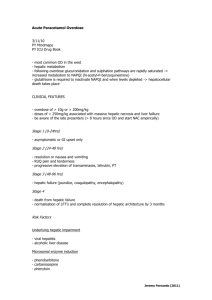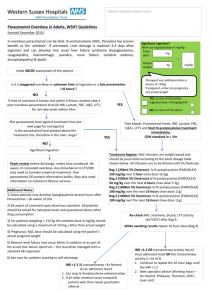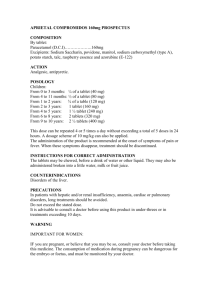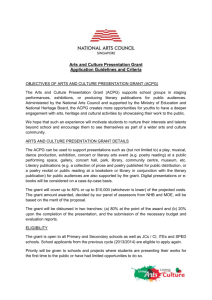Question 9 - Pass the FracP
advertisement
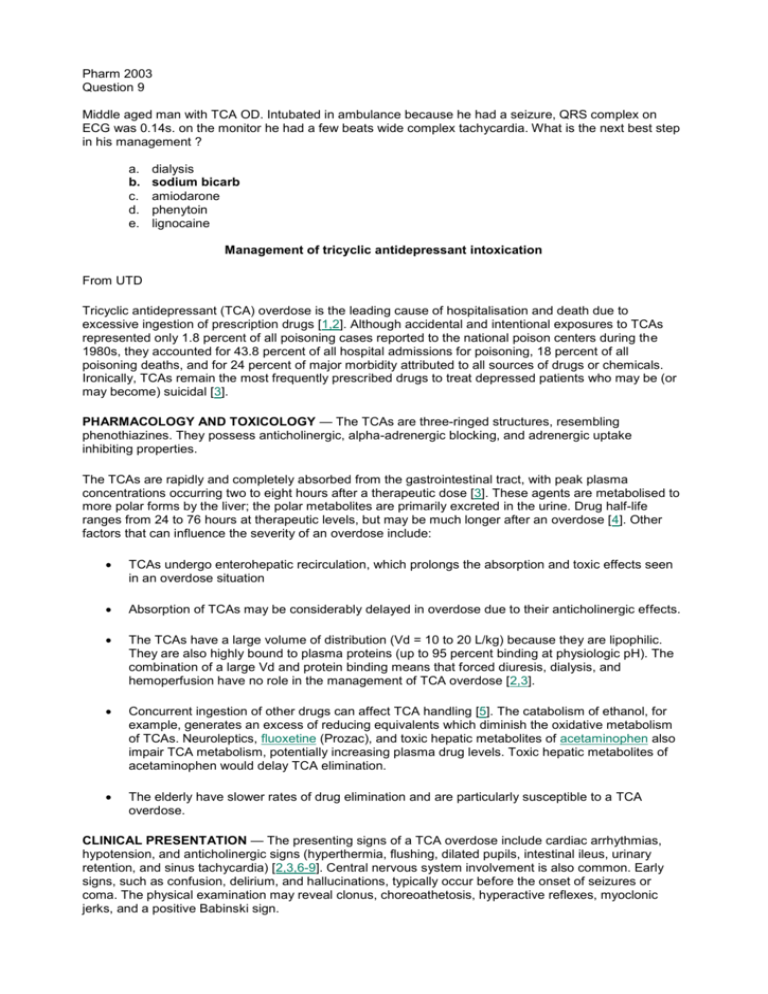
Pharm 2003 Question 9 Middle aged man with TCA OD. Intubated in ambulance because he had a seizure, QRS complex on ECG was 0.14s. on the monitor he had a few beats wide complex tachycardia. What is the next best step in his management ? a. b. c. d. e. dialysis sodium bicarb amiodarone phenytoin lignocaine Management of tricyclic antidepressant intoxication From UTD Tricyclic antidepressant (TCA) overdose is the leading cause of hospitalisation and death due to excessive ingestion of prescription drugs [1,2]. Although accidental and intentional exposures to TCAs represented only 1.8 percent of all poisoning cases reported to the national poison centers during the 1980s, they accounted for 43.8 percent of all hospital admissions for poisoning, 18 percent of all poisoning deaths, and for 24 percent of major morbidity attributed to all sources of drugs or chemicals. Ironically, TCAs remain the most frequently prescribed drugs to treat depressed patients who may be (or may become) suicidal [3]. PHARMACOLOGY AND TOXICOLOGY — The TCAs are three-ringed structures, resembling phenothiazines. They possess anticholinergic, alpha-adrenergic blocking, and adrenergic uptake inhibiting properties. The TCAs are rapidly and completely absorbed from the gastrointestinal tract, with peak plasma concentrations occurring two to eight hours after a therapeutic dose [3]. These agents are metabolised to more polar forms by the liver; the polar metabolites are primarily excreted in the urine. Drug half-life ranges from 24 to 76 hours at therapeutic levels, but may be much longer after an overdose [4]. Other factors that can influence the severity of an overdose include: TCAs undergo enterohepatic recirculation, which prolongs the absorption and toxic effects seen in an overdose situation Absorption of TCAs may be considerably delayed in overdose due to their anticholinergic effects. The TCAs have a large volume of distribution (Vd = 10 to 20 L/kg) because they are lipophilic. They are also highly bound to plasma proteins (up to 95 percent binding at physiologic pH). The combination of a large Vd and protein binding means that forced diuresis, dialysis, and hemoperfusion have no role in the management of TCA overdose [2,3]. Concurrent ingestion of other drugs can affect TCA handling [5]. The catabolism of ethanol, for example, generates an excess of reducing equivalents which diminish the oxidative metabolism of TCAs. Neuroleptics, fluoxetine (Prozac), and toxic hepatic metabolites of acetaminophen also impair TCA metabolism, potentially increasing plasma drug levels. Toxic hepatic metabolites of acetaminophen would delay TCA elimination. The elderly have slower rates of drug elimination and are particularly susceptible to a TCA overdose. CLINICAL PRESENTATION — The presenting signs of a TCA overdose include cardiac arrhythmias, hypotension, and anticholinergic signs (hyperthermia, flushing, dilated pupils, intestinal ileus, urinary retention, and sinus tachycardia) [2,3,6-9]. Central nervous system involvement is also common. Early signs, such as confusion, delirium, and hallucinations, typically occur before the onset of seizures or coma. The physical examination may reveal clonus, choreoathetosis, hyperactive reflexes, myoclonic jerks, and a positive Babinski sign. Cardiotoxic effects are responsible for the mortality in TCA overdose. This usually occurs after the ingestion of more than one gram (10 to 20 mg/kg), which can lead to plasma levels above 1000 ng/mL [2]. The most important electrophysiologic action of TCAs is inhibition of the fast sodium channel, leading to slowing of phase 0 depolarisation in His-Purkinje tissue and the myocardium [2,3,7]. This toxic effect, which is inhibited by sodium bicarbonate (see below), slows conduction with resultant QRS prolongation and the potential emergence of re-entry arrhythmias (such as ventricular tachycardia, ventricular fibrillation, and torsade de pointes). As noted above, sinus tachycardia occurs early in TCA overdose when anticholinergic symptoms predominate, and may be difficult to distinguish from ventricular tachycardia in the presence of a wide QRS. There is a variable time course for the resolution of these ECG changes. One study of 36 patients with significant, acute TCA ingestions found that 42 percent failed to normalize their QRS interval to 100 msec within 24 hours [10]. No prognostic impact of protracted QRS widening was detected. Hypotension and pulmonary oedema are other common findings in TCA overdose. The fall in blood pressure is due both to impaired myocardial contractility and to decreased peripheral vascular resistance induced by alpha-adrenergic blockade [2,3,9,11]. The decrease in contractility also contributes to pulmonary oedema which can be exacerbated by fluid overload. For this reason, TCA toxicity must be managed with only maintenance fluid replacement (unless the patient is hypotensive) and preferably with central hemodynamic monitoring in the intensive care unit setting [2,3]. TREATMENT — The general approach to any poisoned patient must include the following elements: Evaluation, including the recognition that poisoning has occurred, identification of the agents involved, assessment of severity, and prediction of toxicity. (See "General approach to drug intoxications in adults"). Management, consisting of supportive care, prevention of drug absorption, and, when appropriate, the administration of antidotes and enhancement of drug elimination. (See "Decontamination of poisoned adults" and see "Enhanced elimination of poisons"). Treatment of TCA overdose must be aggressive from the outset. Initial therapy consists of establishing airway and breathing, continuous electrocardiographic monitoring, gastric lavage, and the administration of activated charcoal[2,3,11]. In contrast, syrup of ipecac is contraindicated with any TCA ingestion due to the possibility of rapid neurological deterioration and high incidence of seizures. Gastric decontamination can be considered for up to 12 hours after ingestion because the anticholinergic properties of these drugs delay gastric emptying. TCAs in the gastrointestinal tract are well absorbed by activated charcoal at a 10:1, charcoal-to-drug ratio. The initial recommended dose of charcoal, 1 to 2 gm/kg body weight, should be given with a cathartic, such as sorbitol or magnesium citrate[11]. This may be followed by an additional two to three doses at intervals of several hours. These doses can be given with water if catharsis is adequate or with a cathartic if bowel motility is minimal. Antibodies against TCA moieties are currently undergoing evaluation; they may improve outcomes by binding to TCA molecules, thereby decreasing concentrations of the free drug. An early report described rapid reversal of cardiac and neurologic toxicity in a patient with a severe amitriptyline overdose when Fab fragments of ovine anti-TCA antibodies were infused [12]. Phase II trials of this therapy are underway. Sodium bicarbonate — Intravenous sodium bicarbonate is the single most effective intervention for the management of TCA cardiovascular toxicity [13-15]. This agent can reverse QRS prolongation, ventricular arrhythmias, and hypotension. Because acidosis aggravates TCA toxicity, the beneficial action of sodium bicarbonate may be partly due to correction of acidosis. It is clear, however, that sodium bicarbonate administration is effective even when the arterial pH is normal. This beneficial effect appears to be mediated by increases in both pH and the plasma sodium concentration [16]. Alkalinization to an arterial pH of 7.5, for example, appears to reduce the incidence of cardiac arrhythmias and intravenous sodium bicarbonate (in a dose of 1 to 2 meq/kg) is the treatment of choice for sudden-onset ventricular tachycardia, ventricular fibrillation, or cardiac arrest. To maintain an arterial pH of 7.5, an intravenous infusion of two 50 mL ampuls of sodium bicarbonate (containing approximately 90 meq of sodium bicarbonate) in one litre of five percent dextrose in water is started in all comatose patients, particularly those with a QRS duration above 0.10 sec (100 msec). Arrhythmias — Lidocaine is the drug of choice for TCA-induced ventricular dysrhythmias. However, care must be taken to avoid precipitation of seizures. In comparison, many antiarrhythmic drugs should not be used with TCA overdoses. Propranolol, for example, depresses myocardial contractility and conduction while procainamide, disopyramide, and quinidine, via membrane stabilizing effects, may enhance tricyclic toxicity. Hypotension — Intravenous fluids are the preferred therapy in hypotensive patients. Dopamine can be used if needed because it has both inotropic and vasoconstrictor activity. On the other hand, sympathomimetic vasopressor agents carry the risk of precipitating tachyarrhythmias. Levarterenol is generally considered an adjunctive pressor agent [2,11,17]. Seizures — Diazepam is the drug of choice in the management of acute-onset seizures. Phenytoin or phenobarbital may be used as second-line drugs. Physostigmine — Physostigmine, a short-acting cholinesterase inhibitor, has been referred to as the antidote for TCAs because of its ability to increase cholinergic tone and reverse anticholinergic effects. It can, however, causes severe bradycardia, seizures, and asystole by overcompensating for cholinergic tone and suppressing supraventricular and ventricular pacemakers [18,19]. In the aggregate, physostigmine-associated risks often outweigh the benefits. As a result, physostigmine should only be used in patients with coma or those with convulsion or arrhythmias resistant to standard therapy Question 10 Young woman admitted with paracetamol OD. Has had ETOH but not chronic drinker. She was last seen at 12am and found at 5am. 6am bloods show paracetamol level of 1100 pmol/l (high for 5 hours post injestion). Normal LFTs and INR. She has had NAC 6/12 previous generalised urticaria from it. What is the most appropriate management ? a. b. c. d. e. administer charcoal give NAC now give H2 antagonist hemoperfusion repeat blood level at 8am and reassess Note better response would be to give antihistamine + NAC now. H2 antagonist and H1 antagonist together better than either agent alone. Even if LFTs abnormal and INR elevated give NAC. Management of paracetamol intoxication From UTD 11.2 Although paracetamol is remarkably safe when used at usual therapeutic doses, overdoses have been recognized to cause fatal and nonfatal hepatic necrosis since 1966 [1]. Given its widespread availability and the fact that lay people commonly underestimate its toxicity, paracetamol accounts for more overdoses and overdose deaths each year in the United States than any other pharmaceutical agent [2]. In 1997, it accounted for 126 deaths (14 percent of all pharmaceutical-related deaths) reported to United States poison centers [2]. Paracetamol poisoning, particularly among alcoholics, has likely become the most common cause of acute liver failure in the United States [3]. The treatment of paracetamol intoxication will be reviewed here. The pathophysiology, clinical manifestations, and diagnosis of this condition are discussed separately. INITIAL TREATMENT — The mainstays of the therapy for paracetamol intoxication include gastrointestinal decontamination with activated charcoal and the administration of N-acetylcysteine. Gastrointestinal decontamination — Activated charcoal (AC) is the preferred method of gastrointestinal decontamination and is indicated for all patients who present within four hours of ingestion. It may be useful beyond four hours in the presence of certain coingestants or when absorption of paracetamol may be delayed (eg, ingestion of sustained-release preparations or an agent that slows gut motility). AC avidly adsorbs paracetamol, reducing its absorption by 50 to 90 percent in simulated human overdose [4]. In one study of 20 patients with actual paracetamol overdose, AC produced a greater mean fall in the serum paracetamol concentration (52 percent) than did gastric lavage or syrup of ipecac[5]. For paracetamol poisoning, AC should be administered as a single oral dose of one gram per kilogram body weight; multiple doses are not warranted. Although AC does adsorb NAC and may reduce its absorption from 8 to 39 percent, it is not necessary to increase the NAC dose when concurrently administered with AC; the amount of NAC absorbed is still well above the amount required to detoxify paracetamol[6]. N-acetylcysteine — N-acetylcysteine (NAC), a glutathione precursor, is the antidote of choice for the treatment of paracetamol poisoning. Mechanism of action — Early after overdose, NAC prevents toxicity by limiting the formation and accumulation of NAPQI. NAC increases glutathione stores [7], combines directly with NAPQI as a glutathione substitute [8], and enhances non-toxic sulfate conjugation [9]. Later after overdose, when hepatotoxicity is established and serum paracetamol is undetectable, NAC is beneficial by other mechanisms. NAC has powerful antiinflammatory and antioxidant effects (as a modifier of cytokine production and a free radical scavenger) that may limit secondary paracetamol-induced tissue injury [1012]. NAC also has inotropic and vasodilating effects, which improve microcirculatory blood flow and oxygen delivery to vital organs [12,13]. Indications — NAC is indicated for in the following situations: Patients with a serum paracetamol concentration above the "possible hepatic toxicity" line of the Rumack-Matthew nomogram (show figure 1) following an acute ingestion. Patients with a single ingestion of greater than 150 mg/kg (or 7.5 g in an adult) by history and for whom results of a serum paracetamol concentration will not be available within 8 hours from the time of ingestion. Patients with an unknown time of ingestion and a serum paracetamol concentration >10 mcg/mL. Patients with laboratory evidence of hepatotoxicity (from mildly elevated aminotransferases to fulminant hepatic failure) and a history of excessive paracetamol ingestion. Patients who have ingested repeated excessive paracetamol doses, have risk factors for paracetamol-induced hepatotoxicity, and a serum paracetamol concentration >10 mcg/mL. Dosage — In the United States, the only NAC treatment regimen currently approved by the Food and Drug Administration consists of a 72-hour oral course given as a 140 mg/kg loading dose followed by 17 doses of 70 mg/kg every 4 hours (total dose 1330 mg/kg) [15]. NAC is available as a 10 or 20 percent (10 or 20 g/100 mL) solution (Mucomyst). It has a "rotten egg" taste and odour that can lead to nausea and vomiting. This complication can be minimized by diluting the initial preparation with soda or fruit juice to a five percent solution before administration. Vomiting is common after oral NAC administration [17,23]; if it occurs within one hour of a dose, the dose should be repeated. Other measures that can reduce emesis include chilling the solution with ice, closing the nostrils during ingestion, sipping the solution slowly through a straw from a sealed container, or slow administration via nasogastric or duodenal tube. If such measures fail, antiemetic drugs (eg, metoclopramide, droperidol, ondansetron) should be administered in moderate to high doses [24-26]. In addition to nausea and vomiting, adverse effects of oral NAC include diarrhoea and maculopapular rash. In Australia, Canada, and Great Britain, a pyrogen-free NAC preparation can be administered by continuous intravenous infusion over a 20-hour period (total dose 300 mg/kg) [14]. In the United States, this intravenous NAC formulation has been studied with a 48- and 52-hour dosing protocol, using a dose size and schedule identical to the oral protocol [16,18]; each dose is infused over one hour. The incidence of adverse reactions from intravenous NAC has varied considerably, ranging from 0.2 to 21 percent [17,18,27-29]. Adverse effects include nausea, flushing, urticaria, bronchospasm, angioedema, fever, chills, hypotension, hemolysis, and, rarely, cardiovascular collapse. Anaphylactoid reactions are dose-dependent and usually occur within an hour of initiating NAC infusion, when serum concentrations are highest; discontinuation of infusion and treatment with antihistamines are usually sufficient for their resolution. Resumption of intravenous therapy is acceptable following all but life-threatening reactions [17,29]. Lowering the infusion rate decreases the incidence of adverse events [16]. Oral preparations of NAC have been successfully administered intravenously in circumstances in which enteral delivery was not possible. The oral preparation is identical to the intravenous formulation but has not been certified pyrogen-free by the manufacturer. One report described 76 patients in whom recurrent vomiting, altered mental status, gastrointestinal bleeding, or other conditions contraindicated the use of enteral NAC [29]. These patients were successfully treated intravenously with a diluted oral NAC preparation according to the protocol in Table 1 (show table 1). Adverse reactions occurred in 5.3 percent of patients, (similar to that of the pyrogen-free, intravenous NAC formulation) and included rash, pruritus, and phlebitis; none were life-threatening. Intravenous NAC is recommended for: Patients who cannot tolerate oral NAC due to intractable vomiting and for whom further delay will result in decreased NAC efficacy (eg, beyond 10 hours). Patients whose medical condition precludes enteral use of NAC (eg, corrosive ingestion, gastrointestinal bleeding or obstruction). Patients with fulminant hepatic failure, because intravenous NAC results in higher serum concentrations and is the only route that has been studied and shown beneficial in this setting [30]. Patients who are pregnant, because the higher serum level achieved may facilitate transplacental delivery to the fetus. However, the superiority of intravenous to oral NAC in pregnancy is theoretical, and placental transfer of NAC has not been shown to occur in most animal studies [31,32]. Cimetidine — Cimetidine, an inhibitor of CYP isoenzymes, has been considered for use in paracetamol intoxication because it might slow the formation of toxic metabolites. However, studies in humans have shown that cimetidine, given in a dose of 300 mg every six hours, has no influence on the metabolic disposition of paracetamol and does not reduce peak aminotransferase levels when given eight hours after ingestion [33,34]. It is possible that earlier administration of higher doses might be beneficial. At present, the value of cimetidine is unproven and its use in paracetamol overdose is not recommended. Hemodialysis and hemoperfusion — Although hemodialysis and hemoperfusion can remove paracetamol from plasma, they have not been shown to prevent hepatotoxicity following paracetamol overdose. As a result, these modalities are not recommended in the management of paracetamol intoxication [15,35]. It is possible that the liver dialysis system is of some benefit in patients who present more than ten hours after ingestion [36]. (See "Liver dialysis system for hepatic failure"). MANAGEMENT OF HEPATIC FAILURE — All patients who develop paracetamol-induced hepatic failure should be transferred to a centre specialized in the care of such patients and capable of performing orthotopic liver transplantation. Management consists of careful monitoring, aggressive supportive care, NAC therapy, and liver transplantation for those with poor prognostic features (see below) [17,22]. (See "Fulminant hepatic failure: Definition; aetiology; and prognostic indicators" , see "Overview of the treatment of fulminant hepatic failure", and see "Patient selection for liver transplantation"). NAC should be administered, preferably by the intravenous route, until death or recovery and an INR <2.0 [22,37]. Patients should be closely monitored and treated for hypoglycaemia. Since the PT is an important prognostic factor, fresh frozen plasma is not recommended unless active bleeding is present. Vitamin K may be administered for coagulopathy; a lack of response suggests a poor prognosis whereas an improved PT suggests viable liver tissue [38]. A 1995 seven-year study of 560 patients with paracetamol-induced fulminant hepatic failure demonstrated the improved survival rates that have been achieved with specialized care [37]: The overall survival rate increased from less than 50 percent in 1987 to 78 percent in 1993; for those patients not fulfilling transplant criteria, the survival rate increased from 78 to 90 percent. There was also a reduction in the incidence of severe hepatic encephalopathy during this period from 62 to 40 percent. These improvements were associated with an increase in the number of patients treated with NAC: 40 percent in 1987 versus 78 percent in 1993. As in previous studies, the outcome was best for patients treated with antidote within the first 24 hours. Liver transplantation — Because fulminant hepatic failure from paracetamol has a higher rate of resolution than from other causes of liver failure, the threshold for liver transplantation is slightly higher. Regardless, liver transplantation provides life-saving treatment for a previously untreatable group of patients; its increased availability has resulted in a significant improvement in survival rates [22,37,39-41]. Several prognostic factors have been identified that facilitate appropriate decision-making with regards to liver transplantation: Clinical and laboratory criteria were developed based on a cohort of 588 patients with fulminant hepatic failure in an effort to guide the selection of candidates for liver transplantation [40]. These criteria were subsequently validated in 560 additional patients and are highly predictive of death without transplantation in both paracetamol- and nonparacetamol-induced acute hepatic failure (show table 2) [37]. Patients with a blood pH of <7.3 that fails to correct with fluid resuscitation have a 90 percent mortality rate without liver transplantation and those with a PT greater than 100 seconds, a serum creatinine concentration greater than 3.3 mg/dL, and grade III or IV encephalopathy have a mortality rate of 81 percent without transplantation. In contrast, patients with these poor prognostic signs who underwent liver transplantation had a 66 percent one-year survival rate. In the second cohort described above, it was noted that patients with grade I or II encephalopathy had a survival rate of greater than 95 percent whereas those with cerebral oedema had only a 22 percent survival rate [37]. In addition, patients that required inotropic support had a survival rate less than 10 percent. Another set of laboratory criteria was developed and validated using a group of 548 patients. Criteria include: the presence of a progressive coagulopathy in which the PT in seconds exceeds the time in hours after overdose; an INR >5.0 at any time; or evidence of metabolic acidosis; hypoglycaemia; or renal failure [41]. Ninety-four percent of patients without these criteria survived, compared with 44 percent of patients in whom one or more criteria were present. The PT is also a useful early prognostic indicator. In one study of 150 consecutive patients, those with a continued increase in PT on day 4 after overdose and a peak PT greater than or equal to 180 seconds had a survival rate below 8 percent; those with a peak PT less than 90 seconds had an 81 percent survival rate [39]. Experimental therapies — Ongoing clinical trials are evaluating the efficacy of bioartificial livers in the treatment of paracetamol-induced fulminant hepatic failure. Preliminary results suggest this modality provides some benefit in this setting [42]. (See "Liver support systems").
